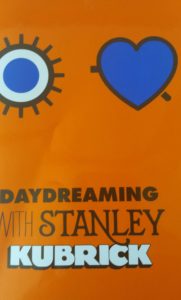 This thought-provoking Somerset House exhibition, ‘Daydreaming with Stanley Kubrick’ ends on 24th August. I went along last week to view works created in response to or inspired by, Kubrick’s films.
This thought-provoking Somerset House exhibition, ‘Daydreaming with Stanley Kubrick’ ends on 24th August. I went along last week to view works created in response to or inspired by, Kubrick’s films.
The exhibition is the brain-child of musician and music producer James Lavelle, who also curates it. He asked over fifty artists to create art works inspired by the films of Stanley Kubrick, the film director who died in 1999. For non-cineastes, these include ‘Lolita‘, ‘Dr Strangelove, or How I learned to Love the Bomb‘, ‘2001: A Space Odyssey‘, ‘Barry Lyndon‘, ‘Full Metal Jacket‘, ‘The Shining‘, ‘A Clockwork Orange‘ and ‘Eyes Wide Shut‘. Whilst I wouldn’t describe myself as a particular Kubrick fan, I have seen all of these save the last and regard him as a serious and influential film-maker ( the list above may not be exhaustive, but, my, is it impressive ).
This exhibition includes works which range from sculpture and painting of the ‘classic’ type, through 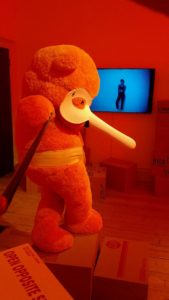 film, installation ( including smell ) to taxidermy and LED-technology visual echoing. Some are very clever, some challenging and overall, the exhibition does what good conceptual art is supposed to do – it makes one think and, in this instance, sends you back to the source material. I immediately wanted to watch Kubrick’s films again.
film, installation ( including smell ) to taxidermy and LED-technology visual echoing. Some are very clever, some challenging and overall, the exhibition does what good conceptual art is supposed to do – it makes one think and, in this instance, sends you back to the source material. I immediately wanted to watch Kubrick’s films again.
The exhibitors have mustered a first-rate list of collaborators from different disciplines, from Jarvis Cocker ( in a Dies Irae ) to ‘Game of Thrones‘ star Aidan Gillan, Cate Blanchett, Samantha Morton and Joanna Lumley. The artists themselves include Sarah Lucas ( though her piece wasn’t my favourite ) through to Anish Kapoor ( whose joint installation with Haroon Mizra really set one’s teeth on edge ).
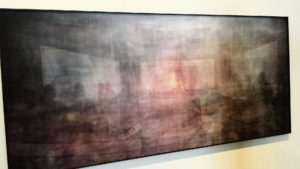 There are direct references – Mat Collinshaw’s primate, Broomberg & Chanarin’s recreation on the floor of the exhibition of the pattern on the carpet in the corridors of the hotel in ‘The Shining‘, Doug Foster’s ‘tunnel’. There are also works which get their inspiration from Kubrick, for example, I liked Marc Quinn’s two heightened and suggestive ‘History Painting’ canvases; and works which deconstruct specific Kubrick works, such as Michael Nyman’s video with music or Jason Shulman’s condensation, via durational photography, of ‘2001‘ ( above left ).
There are direct references – Mat Collinshaw’s primate, Broomberg & Chanarin’s recreation on the floor of the exhibition of the pattern on the carpet in the corridors of the hotel in ‘The Shining‘, Doug Foster’s ‘tunnel’. There are also works which get their inspiration from Kubrick, for example, I liked Marc Quinn’s two heightened and suggestive ‘History Painting’ canvases; and works which deconstruct specific Kubrick works, such as Michael Nyman’s video with music or Jason Shulman’s condensation, via durational photography, of ‘2001‘ ( above left ).
The exhibition is certainly immersive, never more so than when standing inside Toby Dye’s impressive ‘The Corridor‘. This installation has four films, one film showing on the whole of one wall of a darkened, four-walled room. It is intellectually engaging and sometimes disturbing. Each film is set in the same corridor, so the viewer stands at the centre of a ‘crossroads’ of the four corridors and each features a different, life-size character(s) inspired by Kubrick filmography. The stories unfold, but then the characters start moving from one corridor into the next, or running into the ‘crossroads’.
Your blogger got quite a jolt when the man wearing a red and black checked shirt in one of the films, played by Aidan Gillan, appeared to come and stand right next to her in the flesh. It wasn’t him, of course, just another visitor to the exhibition, wearing a similar shirt, but it gave me a fright ( as it did to 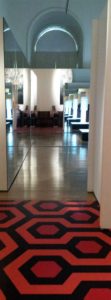 the young man’s girlfriend, who was probably wondering why this middle-aged hysteric had reacted to her boyfriend in such a dramatic way ). Fortunately all became clear.
the young man’s girlfriend, who was probably wondering why this middle-aged hysteric had reacted to her boyfriend in such a dramatic way ). Fortunately all became clear.
Mirrors and tricks with light and perspective figure again and again, most notably in Chris Levine’s LED work, which one can only see by shaking one’s head, and Doug Aitken’s 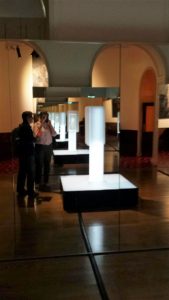 rendition of the phone booth in ‘Dr Strangelove‘, luminous and stretching on into infinity.
rendition of the phone booth in ‘Dr Strangelove‘, luminous and stretching on into infinity.
It seems that there are a few themes running through art this Summer – the representation of one sensory experience in another – synaesthesia, first mentioned in the context of the Georgia O’Keeffe exhibition and her attempts to ‘paint sound’ – is one of them. Infinite regression of mirrors is another, of which more later.
‘Daydreaming with Stanley Kubrick’ is at Somerset House until 24th August and costs £12.50 to enter ( £9.50 concessions ). If you are at all interested in either modern art or the films of Kubrick, it is well worth a visit.
If you enjoyed reading this article you might also enjoy Georgia O’Keeffe Frank Auerbach Eric Ravilious New Tate Modern


 RSS – Posts
RSS – Posts